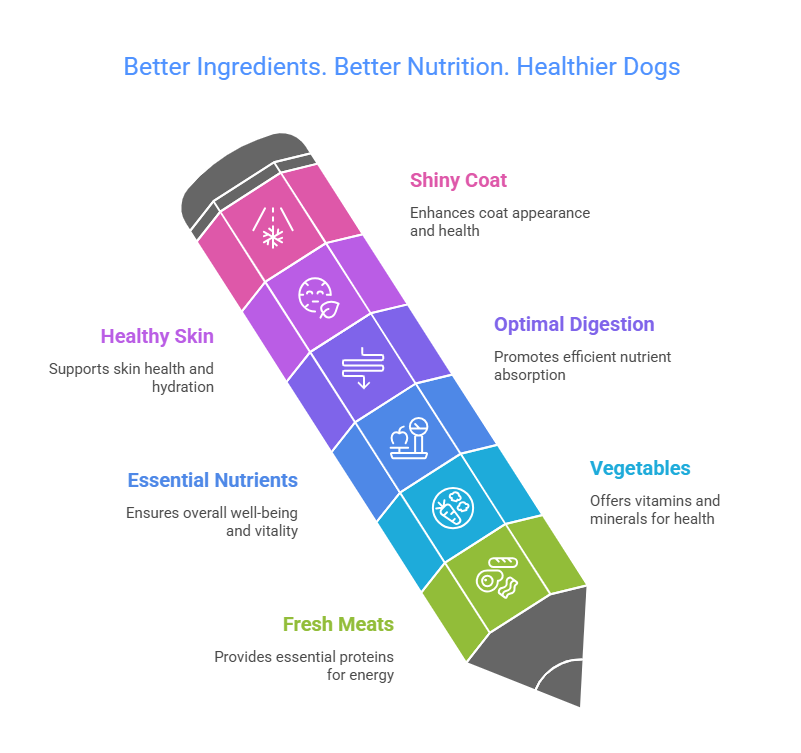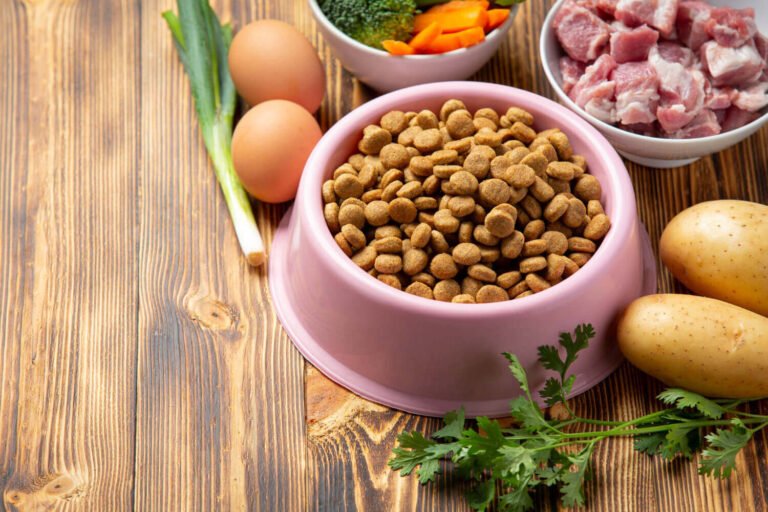Choosing the best dog food 2025 can feel overwhelming with hundreds of brands, mixed advice, and ever-changing ingredients.
But don’t worry, dear pet parents you’ve landed on the only guide you’ll need in 2025. Whether your pup is a picky eater, has allergies, or you’re just trying to find the best food within your budget, we’ve covered it all.
In this master guide, we unpack the best dog foods of 2025, tailored to age, breed, budget, and health needs. You’ll also find actionable tips, a free food comparison tool, and answers to your top FAQs.
Dog Food 101: What Makes It “Good”?
Choosing dog food isn’t just about picking a bag off the shelf—it’s about quality. Let’s break down the key factors:
1. AAFCO Certification
Always check for a statement like “complete & balanced”. That’s your baseline assurance that the food meets nutritional standards for your dog’s life stage.
2. High-Quality Ingredients
- Named meat sources (e.g., “chicken meal,” “salmon”) are better than generic or vague terms like “meat by-products.”
- Avoid fillers such as corn or soy.
Healthy fats, digestible carbs, and natural preservatives = win.
3. Lifecycle-Appropriate Formulas
Puppies need more protein and fat; seniors benefit from joint supplements and fewer calories. Always choose the formula that matches your dog’s age, avoid senior food for puppies!
4. Digestibility & Digestive Health
Dog foods with probiotics, prebiotics, and simple grains support healthy digestion and regular bowel movements.
5. Vet Backing & Brand Transparency
Reputable brands publish recall history, sourcing info, and ingredient sourcing. Vet endorsements or veterinary nutritionist reviews add credibility.
Best Dog Food by Age Group
Your dog’s age isn’t just a number—it defines their nutritional needs, energy levels, and digestive capacity. Let’s explore what matters most at each life stage and give you top-rated recommendations tailored for 2025.
1. Best Dog Food for Puppies (0–12/18 months)
Why Puppy Formulas Matter
Puppies grow fast, inside and out. They need high levels of protein, fat, and calcium for bone development, brain growth, and muscle building.
Key Ingredients to Look For:
- DHA (from fish oil) for brain and vision development
- Higher protein & fat for energy and muscle
- Balanced calcium & phosphorus for bone health
- Small kibble size (for small breeds)
Probiotics for building digestive strength
Key Ingredients to Look For:
- DHA (from fish oil) for brain and vision development
- Higher protein & fat for energy and muscle
- Balanced calcium & phosphorus for bone health
- Small kibble size (for small breeds)
Probiotics for building digestive strength
2. Best Dog Food for Adult Dogs (1–7 years)
Once your pup grows up, it’s time to maintain energy and prevent issues like obesity or inflammation.
What Adults Need:
- Moderate protein & fat
- Balanced carbs for steady energy
- Omega fatty acids for skin & coat
- Joint-friendly nutrients for active dogs
3. Best Dog Food for Seniors (7+ years)
Senior dogs may slow down, but their love stays strong. Their diet should support joints, brain function, and digestion.
Must-Have Nutrients:
- Glucosamine & chondroitin (for joints)
- Lower calories (to prevent weight gain)
- Easily digestible protein
Antioxidants (for immune & brain health).
When switching from puppy → adult or adult → senior, transition food gradually over 7–10 days. (We’ll share a full transition guide in Section VII!)
Best Dog Food by Breed Size
Every dog is different, but size matters when it comes to nutrition. Tiny pups have high metabolisms, while giants need joint protection and slow-growth formulas. Here’s how to choose the right food for your dog’s build.
1. Best Dog Food for Small Breeds (Under 20 lbs)
Why It Matters:
Small breeds burn calories faster, have tinier mouths, and can be prone to dental issues, hypoglycemia, or sensitive tummies.
What to Look For:
- Calorie-dense formulas (to support fast metabolism)
- Small kibble (easy to chew)
- Dental health support
- Digestive-friendly ingredients
2. Best Dog Food for Medium Breeds (20–60 lbs)
Why It Matters:
Medium dogs are versatile, and so should their food be. Balanced nutrition helps them stay energetic without gaining extra weight.
What to Look For:
- Balanced protein and fat
- Support for skin, coat, and joints
- A variety of protein sources for active dogs
3. Best Dog Food for Large & Giant Breeds (60+ lbs)
Why It Matters:
Big dogs face unique issues—joint stress, bloat risk, and slow metabolism. Their food should help them grow slowly and stay mobile.
What to Look For:
- Controlled calcium/phosphorus levels (especially for puppies)
- Larger kibble (helps with chewing & slows eating)
- Joint-supporting supplements (glucosamine, chondroitin)
- Lower fat intake to prevent obesity
For large and giant breed puppies, avoid overfeeding. Too-rapid growth = long-term joint damage. Stick to formulas labeled specifically for “large breed puppies.”
Want to more guide about Best Dog Food by Breed Size read our article to gain more knowledge.
Best Dog Food for Specific Needs (Allergy & Health Guide)
No two dogs are the same—some have itchy skin, others have sensitive tummies, and some just need help shedding a few extra pounds. This section helps you match the right food to your dog’s unique needs, ensuring they feel their best every day
1. Dogs with Food Allergies or Sensitivities
What Are Dog Food Allergies?
Dog food allergies happen when your dog’s immune system overreacts to a specific ingredient, often chicken, beef, dairy, wheat, soy, or corn.
Signs of Food Allergies:
- Itchy skin or excessive licking
- Chronic ear infections
- Upset stomach (vomiting/diarrhea)
- Red, inflamed paws
What to Look For:
- Limited Ingredient Diets (LID): Fewer ingredients = fewer triggers
- Novel Proteins: Such as venison, duck, kangaroo
- Hydrolyzed Protein: Pre-broken down so the immune system doesn’t react
- Grain-free or gluten-free options (if recommended by vet)
2. Dogs with Sensitive Stomachs
Common Signs:
- Gas
- Loose stools
- Vomiting after meals
- Reluctance to eat
What to Look For:
- Easily digestible ingredients (e.g, rice, pumpkin, lamb)
- No artificial additives or fillers
- Prebiotics and probiotics
- Single-source protein
3. Dogs Needing Weight Management
Why It Matters:
Overweight dogs are at risk for arthritis, diabetes, heart issues, and a shortened lifespan.
What to Look For:
- Lower calorie density
- High fiber for satiety
- Lean protein (like turkey, whitefish)
- No high-calorie fillers
4. Dogs with Joint Issues
Common Signs:
- Limping
- Difficulty standing or jumping
- Stiffness after rest
- Reluctance to exercise
What to Look For:
- Glucosamine & Chondroitin (natural joint support)
- Omega-3 fatty acids (reduce inflammation)
- Antioxidants (fight joint degradation)
If you’re still unsure about reading dog food labels or spotting harmful ingredients, you can also check this guide to decoding dog food ingredients for more clarity.
Some dogs fall into multiple categories (e.g, overweight + allergic). Choose a limited-ingredient, weight-control formula, or speak to your vet for a tailored blend.
Best Dog Food for Specific Needs (Allergy & Health Guide)
Because feeding your dog well shouldn’t break the bank.
We understand every pet parent has a different budget. The good news? You can still find nutritious, safe, and satisfying meals for your dog at every price point. Here’s how to choose the best value without sacrificing quality.
1. Budget-Friendly Dog Food Options
Great for everyday feeding, multi-dog homes, or tight monthly budgets.
What to Look For:
- Meets AAFCO standards
- Named meat protein as the first ingredient (e.g., “chicken” not “meat meal”)
- Minimal fillers (avoid corn, wheat, and soy if possible)
- No artificial colors/preservatives
- Trusted brands with a clean recall history
2. Mid-Range Dog Food
Perfect for pet parents who want better ingredients without premium prices.
What to Look For:
- Higher meat content
- Probiotics, omega fatty acids, and joint supplements
- Transparent sourcing (USDA-inspected meat, local farms)
- LID or grain-free options available
3. Premium/High-End Dog Food
For dogs with special needs or parents who want the absolute best.
What to Look For:
- Human-grade ingredients
- Fresh or raw feeding options
- Grain-free or customized formulas
- Zero fillers, artificial ingredients, or by-products
- Tailored to life stage, breed, or condition
To make informed decisions about your dog’s nutrition, food brand, explore our Dog Food Comparison Tool, where you can easily compare leading brands based on nutrition, grain-free status, protein content, and more all in one place.

Sometimes, it’s not about how much you spend, but how wisely you choose. Even budget options can keep your dog healthy if:
- The ingredients are clean
- The food is properly stored
- You consult your vet if your dog has specific needs
How to Transition Your Dog's Food Safely
Change is good — but not all at once.
Switching your dog’s food isn’t just about what’s in the bowl — it’s about how you introduce it. A sudden change can upset your dog’s stomach and cause diarrhea, vomiting, or refusal to eat. Here’s how to make the transition smooth, safe, and stress-free.
Why Gradual Transition Matters
Just like humans, dogs have sensitive digestive systems. A slow transition allows:
- Gut bacteria to adjust
- Enzymes to adapt to new ingredients
- Fewer chances of digestive upset
Step-by-Step Transition Plan
Day | New Food | Old Food |
1–2 | 25% | 75% |
3–4 | 50% | 50% |
5–6 | 75% | 25% |
7+ | 100% | 0% |
Tip: Mix both foods thoroughly in the same bowl, and always feed at the same time each day.
Watch for Signs of Trouble
During the transition, keep an eye on:
- Stool quality (loose, too hard, or changes in color)
- Appetite (sudden disinterest in food)
- Energy level
- Skin reactions
If symptoms persist for more than 2–3 days, pause the transition or consult your vet.
- Add warm water or low-sodium bone broth to enhance flavor.
- Use a bit of the old food as a topping to encourage eating.
- Avoid giving too many treats — this can interfere with digestion.
When to Extend the Transition
- For puppies, seniors, or dogs with sensitive stomachs, a 14-day transition may be safer.
- If switching between types (e.g., dry to raw/fresh), give your dog time to adapt.
- Always read the feeding guide on the new food label — not all brands have the same serving size.
When to Consult Your Veterinarian
Because no article can replace a professional.
While this guide is packed with research, real-life insights, and vet-backed tips, your veterinarian knows your dog best. When it comes to personalized nutrition, especially in the case of underlying health issues, a professional opinion is priceless.
When to Seek Vet Guidance
1.Persistent Digestive Issues
If your dog has chronic diarrhea, vomiting, bloating, or gas even after trying different foods, it could be a sign of:
- Food allergy
- Parasites
- Inflammatory bowel disease
- Pancreatitis
2.Sudden Weight Gain or Loss
Unexplained weight changes may signal a metabolic disorder, thyroid issue, or need for a customized feeding plan.
3.Lethargy or Behavioral Changes
A diet low in essential nutrients like B vitamins or omega-3s can cause mood swings or fatigue.
4.Skin & Coat Problems
Dull fur, excessive shedding, itchiness, or red patches may stem from food sensitivities, low-quality fats, or missing micronutrients.
5.Pre-Existing Conditions
Dogs with:
- Diabetes
- Kidney disease
- Heart conditions
- Joint issues
need therapeutic or prescription diets that only your vet should recommend.
Don’t Guess When It Comes to Health
Just because a food is popular or well-rated doesn’t mean it’s right for your pup. Your vet can:
- Run allergy or sensitivity tests
- Recommend a custom nutrition plan
- Suggest supplements (if needed)
Example Scenarios When to Call Your Vet:
Situation | Why It Matters |
The dog stops eating after new food | This may indicate a reaction or dislike |
Excessive itching | It could be a food allergy |
Puppy is growing too fast | Risk of orthopedic problems |
Senior dog losing appetite | May need a more digestible diet |
Talking to Your Vet? Ask These Questions:
- “Is this dog food suitable for my dog’s age and breed?”
- “Does my dog need grain-free or grain-inclusive food?”
- “Should I test for allergies before switching diets?”
- “What supplements (if any) do you recommend?”
Conclusion: Making the Best Choice for Your Companion
Choosing the right dog food in 2025 isn’t just about brands or trends, it’s about understanding your dog’s unique needs, lifestyle, and health. Whether you have a bouncy puppy, a mellow senior, or a sensitive rescue with food allergies, the right nutrition can transform your dog’s life from coat shine and energy to gut health and longevity.
Here’s your takeaway checklist:
- Know your dog’s stage of life and health condition
- Check for AAFCO compliance and look beyond the marketing
- Read ingredient labels like a detective
- Consult your vet before big changes, especially for medical conditions
- Balance budget with nutritional value even affordable options can be great with the right info
You’re Not Alone — We’re With You
At PetCareUA, we’re more than just a blog. We’re a growing family of dog lovers, committed to sharing trustworthy, vet-informed, experience-backed insights. Your dog’s well-being is our mission.
Bookmark this guide, share it with fellow pet parents, and explore our comparison tools, feeding calculators, and breed-specific articles.
Final Thought:
The best dog food isn’t the most expensive or most popular, it’s the one that helps your dog thrive, not just survive.
Let’s raise healthy, happy dogs together.
Food for Dogs FAQs (2025 Edition)
Answers to the Most Common Questions from Dog Parents Like You
We’ve gathered the top questions pet parents ask straight from search engines, vets, and our own community and answered them clearly to help you make smart, confident food choices for your dog.
Best Dog Food 2025 (FAQs)
Is grain-free dog food always better for allergies?
Not always.
Grain-free diets were once seen as a solution to dog allergies, but research shows most food allergies in dogs are due to proteins like beef, chicken, or dairy, not grains. Some grains, like brown rice or oats, are nutritious and help with digestion and energy.
Pro Tip: Choose grain-free *only if your vet recommends it based on allergy tests.
How do I know if my dog has a food allergy?
Watch for:
- Itchy skin, paws, or ears
- Chronic diarrhea or vomiting
- Hot spots or hair loss
Your vet can perform an elimination diet or prescribe hydrolyzed protein food to confirm.
Can I feed my dog human food?
Some human foods are safe (e.g., plain chicken, carrots, pumpkin), but many are toxic (like chocolate, onions, grapes).
When in doubt, check our “Safe Human Foods for Dogs” guide or ask your vet.
How much should I feed my dog?
It depends on:
- Your dog’s weight, breed, and activity level
- The caloric density of the food
Always check the feeding chart on the dog food label, but adjust based on your dog’s body condition.
What’s the difference between “limited ingredient” and “hypoallergenic” food?
- Limited Ingredient Diet (LID): Uses fewer ingredients to minimize reactions, often with novel proteins like duck or kangaroo.
- Hypoallergenic Food: Usually veterinary-prescribed, containing hydrolyzed proteins that don’t trigger immune responses.
How often should I change my dog’s food?
If your dog is doing well, no need to change often. But you can rotate food every 3–6 months (same brand, different recipe) to give nutritional variety if your dog has no sensitivities.
Never change food abruptly — always transition gradually.
Which dog food is best for dogs with allergies?
Look for limited-ingredient or hydrolyzed protein formulas — vet-recommended is best.
What is the best budget-friendly dog food?
Brands like American Journey, Iams, or Nutro offer good quality at lower prices.
What is the best food for aging dogs?
Look for senior formulas with joint support, antioxidants, and easy-to-digest proteins.
What dog food has the fewest allergies?
Hydrolyzed protein diets have the lowest allergenic risk and are often used under vet guidance.
What to feed dogs to stop allergies?
Single-protein, grain-inclusive LID diets can help avoid common triggers like beef, dairy, and wheat.
What is the best allergy-free dog?
While no dog is 100% allergy-proof, breeds like Poodles, Bichon Frise, and Maltese tend to be more allergy-friendly.




